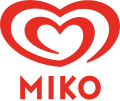Miko (ice cream)
This article is an orphan, as no other articles link to it. Please introduce links to this page from related articles; try the Find link tool for suggestions. (August 2024) |
 | |
| Product type | |
|---|---|
| Owner | Unilever |
| Country | France |
| Introduced | 1920 |
| Website | www |
Miko is a French ice cream brand and company owned by the Unilever group, originally created by Luis Ortiz in Saint-Dizier in the 1920s.
History
[edit]Miko's origins lie in the emigration of the Spanish Ortiz family to France in the 1920s. Some settled in 1919 in Deauville and Trouville where they created Glaces Pompon. One of their cousins, Luis Ortiz (1889-1948), born in San Pedro del Romeral, established himself as a traveling merchant in Saint-Dizier (Haute-Marne) in 1921.[1] He drives his street vendor's cart there to sell his roasted chestnuts, complementing this activity by making ice cream. At the same time, the American Christian K. Nelson discovered the property of coconut oil used to fix the chocolate around the stick, and created the Eskimo.[2]
A cousin of the Ortiz imported the idea in 1925, giving birth to the Ortiz stick.[3] Parents and children crisscross the region aboard scooters. The sale of ice cream increased after the Liberation. American troops are numerous in Saint-Dizier and G.I. fans of “ice creams” discover Ortiz ice creams.[4] The success continued with the sale of Miko in fairgrounds and cinemas. Wanting to modernize the brand, the Ortiz renamed their ice cream Miko in 1951 (a contraction of two nicknames: that of the son of a family associate, Michel nicknamed Mik and that of his dog whose name ended with Ko).[5]
To respond to the development of sales, they bought Fort Carré (formerly a beer manufacturer) and installed a factory and automated machines there in 1954 for the manufacture of ice cream imported from America. The “big merchant from Saint-Dizier” even wins ahead of the three industrial groups Motta, Nestlé and Unilever.[6]
In the 1970s and 1980s, the Ortiz-Miko company sponsored cycling teams and the Tour de France.[7] The company employs 1,100 people and supplies 10,000 points of sale. In 1986, it bought the Nantes ice cream manufacturer Frigécréme from BSN.[8] In 1990, Miko was the leading French group in very cold food products with 6,000 employees and 5 billion francs in turnover.[9] The company exports and has a foothold on all continents: American (Canada), African (Egypt, Senegal, Reunion, Djibouti), Oceanic (New Caledonia) and Asian (Japan, Korea).
With the Ortiz heirs fighting over the inheritance, the declining company was bought in 1994 for 413 million euros by Unilever (a group that owns the Cornetto, Motta and Carte d'Or brands).[10] It is integrated into COGESAL, the group's frozen food division, renamed COGESAL-MIKO on this occasion. Miko subsequently replaced the group's ice cream brand, Motta.[11] The Miko factory moves to the Trois-Fontaines industrial zone, still in Saint-Dizier. The MIKO tower of the former factory is today a Miko museum and a cinema.
References
[edit]- ^ (es) [1], sur vallespasiegos.es
- ^ Anne Cooper Funderburg (1995). Chocolate, strawberry, and vanilla: a history of American ice cream. Bowling Green State University Popular Press. p. 184..
- ^ "L'épopée des glaces Ortiz". museemiko.com..
- ^ "Un succès annoncé". museemiko.com..
- ^ R. E. Batchelor, Malliga Chebli-Saadi (1997). French for Marketing. Cambridge University Press. p. 39..
- ^ Christian Jelen, Olivier Oudiette (1970). La Guerre industrielle. Éditions J'ai Lu. p. 118..
- ^ Jean-Louis Le Touzet (8 July 2003). "Miko, une crème de sponsor". liberation.fr..
- ^ Frigécrème saborde sa marque dans les grandes surfaces, Les Échos, 26 janv. 1994
- ^ Jacky Durand (22 July 2010). "Coquillages et crèmes glacées". liberation.fr..
- ^ Unilever fait le ménage chez Miko, sur Libération
- ^ Unilever peut s'emparer du groupe Ortiz-Miko, Les Echos, 17 mars 1994
This article has not been added to any content categories. Please help out by adding categories to it so that it can be listed with similar articles. (August 2024) |
